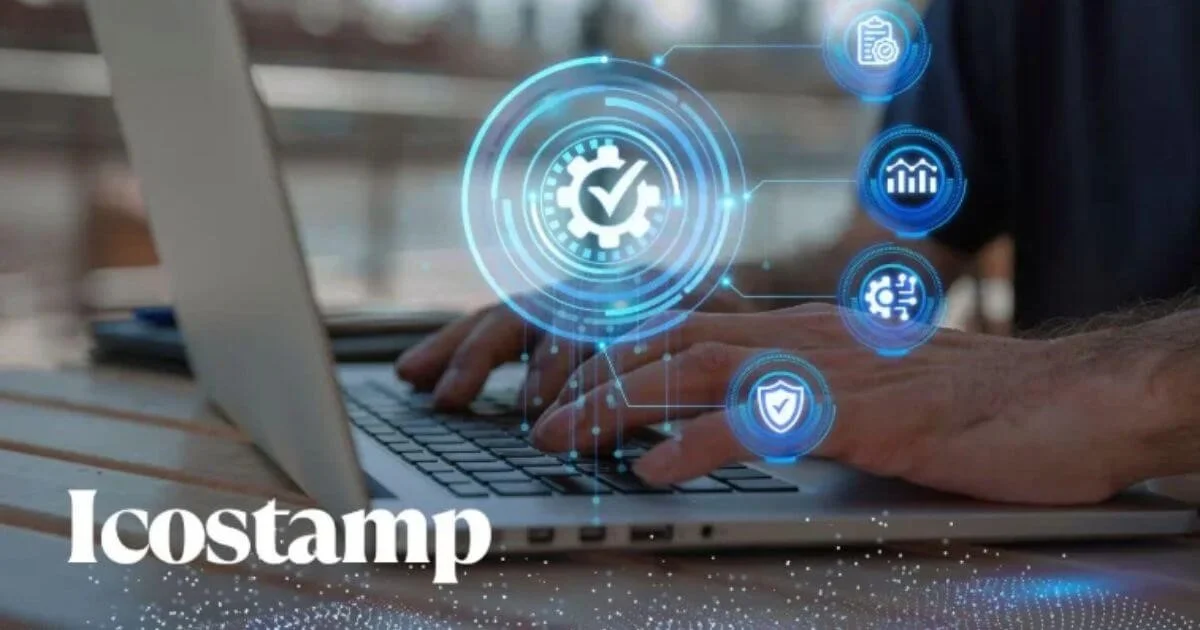In an age where digital trust is more fragile than ever, Icostamp emerges as a compelling technology to anchor certainty in data, identity, and supply chains. Whether you’re in logistics, healthcare, finance, or blockchain, understanding Icostamp gives you a competitive edge. In this article, we explain Icostamp, examine its latest innovations in 2025, detail use cases, weigh pros and cons, and forecast where this field is heading. If you want to embed verifiable trust into your workflows, read on.
What Is Icostamp?
The Core Concept
Icostamp refers to a system (often hybrid of hardware + software or ledger + sensor) designed to log, timestamp, and anchor data or events in an immutable, verifiable way. At heart, it’s about proving when something happened, who triggered it, and that the record hasn’t been altered later.
Variants of Icostamp may emphasize:
-
Smart data loggers that monitor environmental parameters
-
Digital identity systems that issue verifiable credentials
-
Blockchain-anchored timestamping of documents or transactions
-
Evaluation platforms (in crypto contexts) that “stamp” ratings or reviews
The name “Icostamp” sometimes evokes “intelligent stamp,” combining ideas of smart verification and secure logging.
Why the Name Matters
Because “Icostamp” is now used in multiple domains (logistics, identity, crypto review), its precise meaning depends on context. In this article, I cover the broadly applicable principles as well as domain-specific adaptations.
How Modern Icostamp Systems Work (2025 Edition)
Key Building Blocks
-
Sensing or Input Capture
-
In device-based forms, sensors record temperature, humidity, movement, light, etc.
-
In software-based forms, events like file creation, transaction logs, or identity claims are inputs.
-
-
Hashing / Data Digest Creation
-
The input is transformed into a cryptographic hash (e.g. SHA-256 or SHA-3).
-
That hash is unique to the content and changes if even one bit changes.
-
-
Anchoring / Stamping
-
The hash is submitted to a secure, tamper-resistant ledger or database (often a blockchain).
-
The ledger entry includes a timestamp, block height, and proof of inclusion.
-
-
Storage & Linkage
-
The original data may stay off-chain for size/cost reasons.
-
Metadata or pointers connect the data to its anchor hash.
-
-
Verification / Audit
-
Any party can recompute the hash of some content and compare it to the ledger’s version.
-
If they match and ledger proof is valid, the content is confirmed as unchanged since stamping.
-
-
Alerts / Monitoring (optional but common)
-
Some systems include automatic alerts if verification checks fail.
-
Scheduled integrity scans or “heartbeat” logs may run to detect tampering.
-
Recent Enhancements (2024–2025)
-
Edge and on-device analytics: Devices now can pre-process data and detect anomalies locally before sending only critical hashes.
-
Cross-chain anchoring: Some systems write the same hash to multiple blockchains to enhance redundancy.
-
Zero-knowledge proof elements: In identity contexts, claims can be verified without revealing full underlying data.
-
Adaptive frequency stamping: Rather than stamping every meter of data, systems dynamically adjust stamping frequency based on risk or threshold events.
-
Tamper-evident hardware designs: Physical modules now include triggers that detect physical tampering, erasing keys or raising red flags.
Example: A modern Icostamp device could locally monitor temperature in a cold chain container, but only stamp a hash when thresholds are crossed or at scheduled intervals—reducing ledger costs while preserving trust.
Core Advantages of Icostamp
1. Immutable Proof of Existence
Once a hash is anchored on a ledger, it’s effectively irreversible. That gives you proof that a record existed at a given time.
2. Transparent and Trustless Validation
Even parties who are not involved originally can independently verify data integrity and timestamp claims, without a central authority.
3. Enhanced Traceability
Each step in a process—whether movement of goods, updates to a document, or identity claims—can be stamped, producing an auditable chain.
4. Cost Efficiency vs Traditional Notarization
While traditional notarization or third-party auditing can be expensive or slow, Icostamp offers near real-time, low overhead assurance—especially when used efficiently.
5. Application to Compliance & Regulation
Some industries require strict traceable logs (e.g. pharmaceuticals, food safety, medical devices). Icostamp offers stronger, cryptographic assurances for audits.
6. Dispute Mitigation
In disputes over precedence (for instance, originality of a file or creation date), Icostamp provides objective proof anchored in cryptography.
Use Cases & Industry Applications
Logistics & Cold Chain Monitoring
One of the most compelling uses of Icostamp is in monitoring perishable goods during transport. Devices can log environmental metrics and anchor them, so stakeholders at delivery can verify that conditions stayed within limits.
Example: A vaccine shipment travels across borders. Embedded Icostamp loggers measure temperature, humidity, and motion. Any deviation triggers a hash submission. At arrival, recipient rechecks data vs anchors to confirm no manipulation occurred.
Digital Identity & Credentialing
In identity systems, Icostamp can help issue credentials (e.g. licenses, certifications) in a way that allows verifiers to confirm their authenticity and issuance timestamp cryptographically. Modern designs may also support privacy (zero-knowledge).
TechLidar’s recent article emphasizes Icostamp as a next-gen identity tool combining multi-factor authentication, verifiable claims, and decentralized identity standards. TechLidar
Document & Intellectual Property Proof
Authors, inventors, and content creators can hash their work and use Icostamp to timestamp it. In case of dispute, they can prove they held the work at that timestamp.
Crypto / ICO Project Rating & Verification
In the crypto space, some projects use “Icostamp” as a review or rating authority. For example, platforms analyze ICO projects, assign risk scores, and “stamp” them as credible or suspicious. ukrtime.co.ua+1
Healthcare, Medical Devices & Supply Chains
Medical devices, sterile packaging, or biologics shipments benefit from Icostamp verifying environmental conditions and a tamper-evident chain from manufacture to delivery.
High-Value Items & Anti-Counterfeiting
Artworks, luxury goods, or sensitive electronics can be affixed with micro Icostamp tags that log and anchor environmental or chain-of-custody data. This helps deter counterfeiting and provide provenance.
Challenges & Limitations
Cost & Scalability
Writing many hashes to public blockchains can become costly (gas fees). Efficiency strategies are essential to keep it viable for high-frequency applications.
Off-Chain Dependency
Because heavy or raw data is stored off-chain, the security of those systems (servers, databases) must be reliable; otherwise the chain anchor loses context.
Legal & Regulatory Recognition
Cryptographic timestamps are not yet universally accepted in many legal systems. They may need to be supplemented by legally required forms of notarization.
Interoperability & Standardization
Different Icostamp implementations may not talk to each other. Without standards, cross-platform verification is harder.
Physical Security Risks
For on-device systems, theft, tampering, or sensor spoofing remain risks. Secure hardware design is essential.
Latency & Real-Time Constraints
Some real-time systems might need near-instant verification; anchoring to slow or congested blockchains can introduce delay.
How to Choose or Design an Icostamp System (Best Practices)
-
Prioritize hybrid design
Use lightweight anchor stamps combined with off-chain storage and metadata linking. -
Batch or threshold-based stamping
Aggregate multiple events into one hash or only stamp when significant thresholds are crossed. -
Select resilient blockchains
Opt for networks with good uptime, decentralization, and low fee volatility. -
Use tamper-evident hardware
In device cases, design casing or cryptographic keys that erase or alert if breached. -
Adopt open standards where possible
Leverage DID (Decentralized Identity), verifiable credential frameworks, or open timestamp protocols. -
Have fallback retrieval and redundancy
Always replicate critical off-chain data across secure mirrors; log integrity checks regularly. -
Plan legal integration
Supplement cryptographic proofs with legally acceptable formats (e.g. signed certificates) if operating in jurisdictions with stricter rules.
A Case Scenario: Pharma Cold Chain with Icostamp
Suppose a pharmaceutical company ships insulin vials internationally. They embed Icostamp loggers in each carton.
-
At each hour, the devices compute a hash of the accumulated sensor logs and submit to blockchain anchor.
-
The off-chain server stores the full log, tied via metadata to the hash anchor.
-
At arrival, the warehouse operator downloads the logs, recomputes hashes, and checks anchor records.
-
If any discrepancy is found or temperature threshold exceeded, the shipment is flagged before distribution.
-
Regulators can audit the chain to see exactly when and where conditions changed, with cryptographic evidence.
This chain of trust mitigates spoilage risk, supports regulatory compliance, and provides accountability.
Latest Developments & Trends (2025 & Beyond)
-
Edge AI on devices: Devices with processing power now evaluate log patterns and only send abnormal data (smart filtering).
-
Cross-chain stamping: Some systems anchor the same hash to multiple blockchains for redundancy and risk mitigation.
-
Greater privacy support: Zero-knowledge techniques allow proving compliance (e.g. “temperature stayed within limits”) without revealing raw data.
-
Interoperable identity & credential ecosystems: Building bridges between Icostamp identity systems and mainstream identity protocols (OpenID, OAuth, DIDs).
-
Eco-friendly hardware: Biodegradable or low-power modules targeted at mass deployment.
-
Standard bodies & regulation catch-up: Expect ISO, W3C, or national standards to adopt stamping, timestamping, or digital identity frameworks.
-
Hybrid blockchain + ledger aggregation: Some use private ledgers for speed, then anchor snapshots periodically onto public chains to balance performance and trust.
Summary & Final Thoughts
Icostamp is far more than a buzzword: it represents a practical merger of cryptography, sensor hardware, and ledger anchoring to enforce integrity, traceability, and trust. Across industries—from cold chain logistics to digital identity and crypto rating platforms—it offers a modern mechanism to root authenticity in data.
While challenges remain (costs, legal acceptance, standardization), the advancements of 2025—such as edge analytics, cross-chain anchoring, and privacy-preserving proofs—bring Icostamp technology closer to mainstream viability.
If you’re considering a system to anchor trust in your processes—be it supply chain, identity, or document authenticity—embedding an Icostamp-style solution is increasingly compelling. Let me know if you want a version focused on your industry (healthcare, bitcoin, logistics, etc.), or a more concise summary suited for blog publication.








Leave a Reply